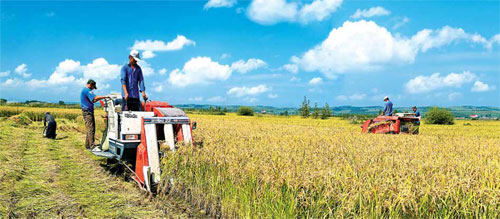Festive 60th birthday for Yanbian
|
The widespread use of machinery today has freed local farmers from the hard toil of previous times. Provided to China Daily |
Only autonomous Korean prefecture borders both Russia and the DPRK
Fluttering ribbons, song and dance, traditional Korean costumes - the festivities are underway as the only autonomous Korean prefecture in the country has already begun to celebrate its 60th birthday, which will be officially marked on Sept 3.
Of the 2.19 million residents in Yanbian prefecture - which borders both Russia and the Democratic People's Republic of Korea in Northeast China's Jilin province - 798,000 are ethnic Koreans.
"Yanbian prefecture has made remarkable achievements in the past six decades, especially since 1978," said Zhang Anshun, the prefecture's Party chief.
That year China began the reform and opening-up policy that also benefited Yanbian, which has since registered average annual growth of 9.5 percent.
Official statistics show that Yanbian's GDP hit 65.2 billion yuan ($10.24 billion) in 2011, 61 times the figure in 1952 when the prefecture was established.
The per capita GDP in the prefecture was more than 29,800 yuan in 2011, some 21 times the level 60 years ago.
The rapid economic development has enabled the government to allocate more funds to improve local infrastructure.
Top transport
Yanbian is now among the autonomous prefectures with the best transport facilities, according to Li Longxi, head of the prefecture, who is also an ethnic Korean.
Residents in six of Yanbian's eight cities and counties now have access to expressways, with the final two expected to join their ranks in 2014, said a local transport official.
Yanji, the capital city of the prefecture, is home to the fifth-largest airport in Northeast China.
Serving flights to 12 cities nationwide including Beijing, Shanghai, Tianjin and Shenyang, the airport also has international flights to Inchon and Busan in the Republic of Korea. It handled more than 1 million passengers in 2011.
The Yanbian government has also enhanced public services for residents, offering nine libraries and 10 museums open free of charge.
More than 500 performances are conducted for Yanbian's rural residents every year, according to a government official.
Official statistics show more than 99.7 percent of residents in the prefecture have access to radio broadcasts and 97.5 percent can view TV programs, some of them in the Korean language.
Medical facilities in the prefecture have also risen to more than 1,200 from fewer than 160 in 1952.
In addition, a range of traditional Korean facilities including a folk custom garden and the China Exhibition Hall for Korean Intangible Heritage have also been established.
Better life
Local residents have also benefited from Yanbian's rapid development.
In 2011, the disposable income for urban residents in the prefecture rose to 19,558 yuan and the net income for rural residents to 6,250 yuan.
The per capita living space was more than 33 sq m for urban residents and nearly 24 sq m in the rural areas in 2011.
The savings of residents in the prefecture totaled more than 60 billion yuan last year, with the per capita figure skyrocketing to nearly 28,000 yuan from just 56 yuan in 1952.
In addition, farmers in the prefecture no longer have to toil as hard, with 82 percent of Yanbian's arable land cultivated with the aid of machinery, said a local agricultural official.
Yanbian's economic achievements are partly due to its geographic location, said the prefecture's Party chief Zhang.
Sharing a nearly 250-km border with Russia and more than 520 km with North Korea, Yanbian is only 15 km from the Sea of Japan. The prefecture itself has 12 dry ports, 60 percent of the province's total, which are driving international trade.
Official statistics show Yanbian's volume of imports and exports totaled $1.86 billion in 2011, an increase of $310 million from 2010, while its labor service exports generated $4.15 billion from 2006 to 2010.
Cross-border program
International trade has flourished since the launch of the UNDP-sponsored Tumen River Area Development Program in 1992, said Zhang.
Also known as the Greater Tumen Initiative, the program is a mechanism for regional cooperation among China, Russia, North Korea, South Korea and Mongolia.
Following the program's success in boosting the regional economy, China has moved to augment the initiative.
In April, China launched a program to build an international cooperation demonstration zone in the prefecture's Hunchun city.
The 90 sq km zone in Hunchun - dubbed China's gateway to Northeast Asia - enjoys national preferential policies on taxes, land use, financial support and pooling of talent, Xinhua news agency reported.
"This will help open Yanbian's doors wider to neighboring countries and promote regional economic prosperity," said Zhang.
In addition, the Rason Economic and Trade Zone, a joint effort by China and North Korea to enhance bilateral economic cooperation, has been making progress.
The prefecture is also making rapid headway in cross-border infrastructure construction.
The highway connecting Quanhe Port in Hunchun to Rajin Port in North Korea has been renovated.
The railway from Tumen city to the port of Rajin has also been refurbished.
Efforts are also under way to resume operation of the railway from Hunchun to Kamyshovaya in Russia.
Zhang said the Yanbian government will take advantage of its geographic location to further boost tourism, another pillar industry of the prefecture.
Yanbian, 80 percent covered by forests, attracted nearly 8.6 million visitors last year, both Chinese and foreign, who came to see the primordial volcanic landscape and rare wild plants in the Changbai Mountains and enjoy traditional Korean food and dances. The industry generated more than 10 billion yuan in 2011.
This year the number of visitors is expected to exceed 10 million, said a local tourism official.
lifusheng@chinadaily.com.cn



















